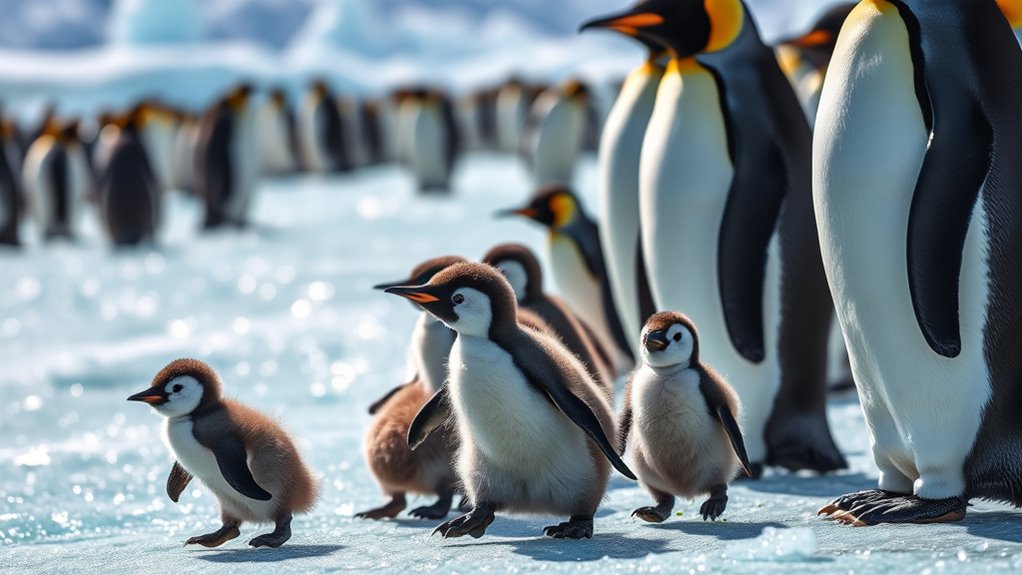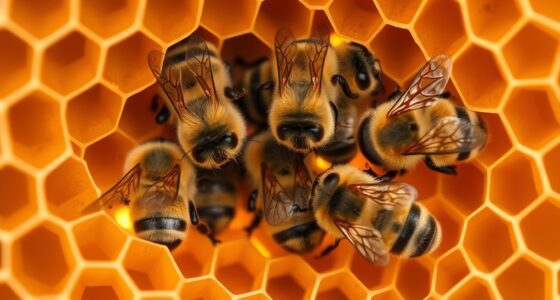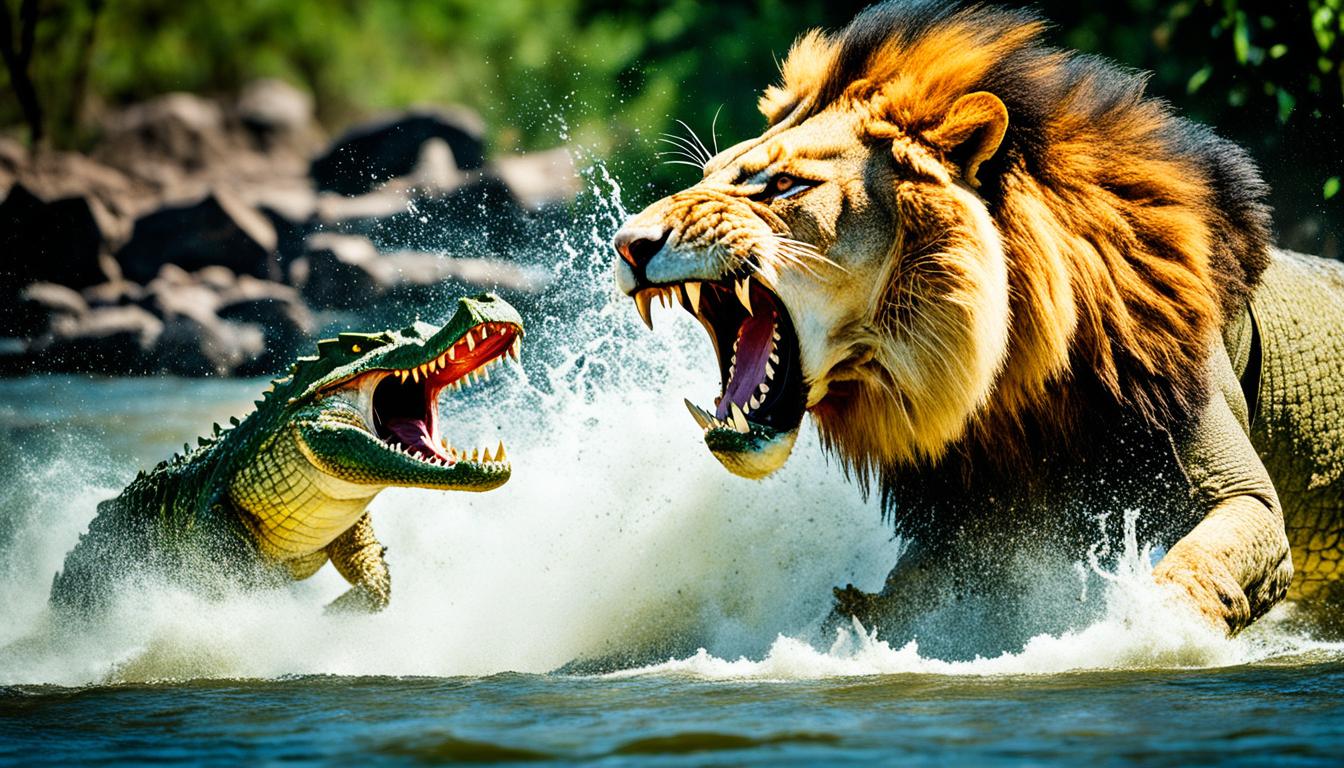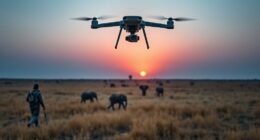Penguins waddle because their anatomy is uniquely adapted for energy-efficient movement. Their shorter, flatter wing bones have evolved into flippers for swimming, while a thicker skeleton supports their buoyant bodies. This waddling motion, characterized by smaller strides, conserves energy and allows quick recovery of up to 80% per step. This adaptation is essential for maneuvering icy terrains, aiding in hunting and migration. Keep exploring, and you'll uncover even more fascinating aspects of penguin life!
Key Takeaways
- Penguins waddle due to their unique anatomical adaptations, including compact ankles and knees that enhance their movement efficiency on land.
- Their flightless evolution led to shorter, flatter wing bones transforming into flippers, contributing to their waddling gait.
- Waddling allows for energy-efficient movement, recovering up to 80% of kinetic energy per stride, crucial for long migrations.
- The waddling motion acts like a pendulum, storing energy for subsequent steps, making them 20% more efficient than humans.
- This method of movement is essential for navigating icy terrain and aids in hunting and evading predators effectively.
Penguin Anatomy and Evolution
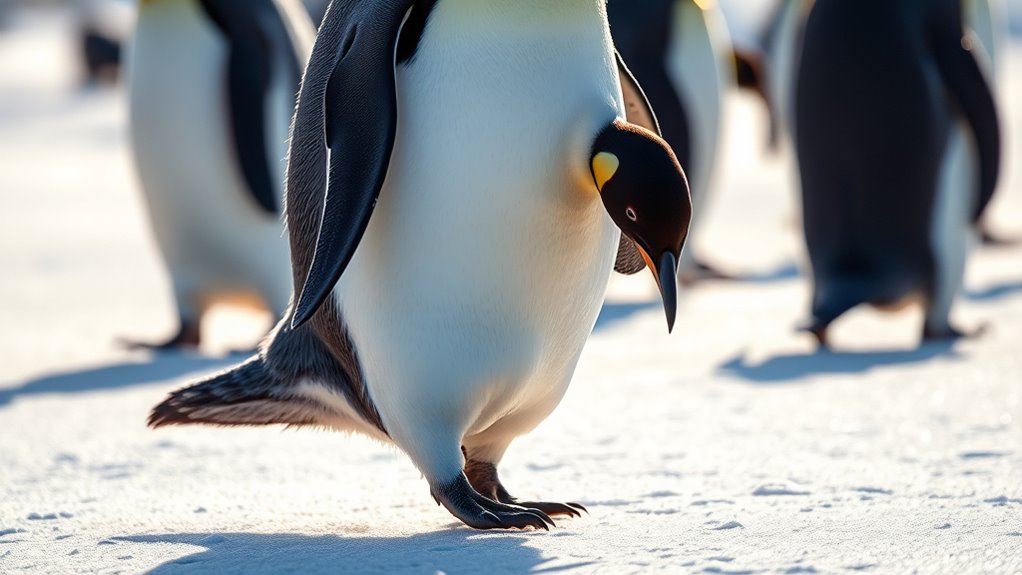
Although penguins once soared through the skies, their evolution into flightless birds has led to fascinating anatomical changes that shape their unique movements today.
As you observe these remarkable creatures, you'll notice their thicker skeletons and shorter, flatter wing bones, which have transformed into streamlined flippers perfect for gliding underwater. The enlargement of their breastbone supports the powerful muscles needed for efficient flapping while swimming, allowing them to reach impressive speeds when hunting.
Additionally, their compact ankles and knees sit within the body cavity, optimizing their movement. These adaptations not only enhance their swimming abilities but also contribute to their distinctive waddling gait, an energy-efficient way to conserve energy as they traverse their icy habitats.
The Mechanics of Waddling
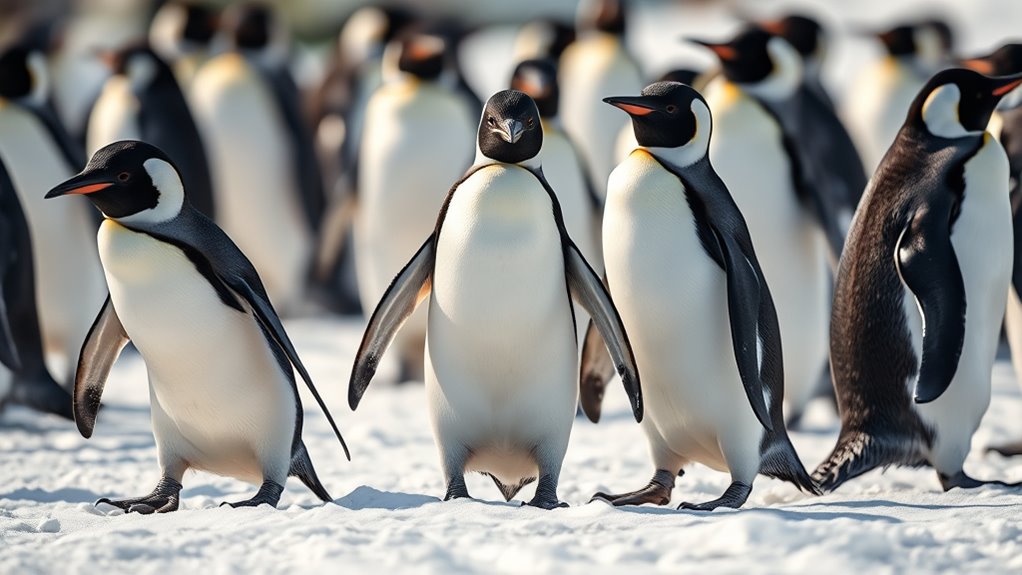
When you watch a penguin waddle, you're witnessing a remarkable energy-efficient movement strategy.
Their unique anatomy allows them to recover kinetic energy with each step, making their gait both effective and economical.
This efficient way of moving is essential, especially during long migrations and when hunting for food.
Energy-Efficient Movement Strategy
Penguins waddle as an energy-efficient movement strategy, allowing them to navigate their environment with remarkable ease. By taking smaller, faster steps, they conserve energy while moving over land. The waddling motion acts like a pendulum, storing kinetic energy for powering subsequent steps, achieving up to 80% energy recovery per stride. This efficiency makes penguins 20% more efficient than humans, enabling them to cover longer distances with less effort. Their compact ankles and streamlined body shape enhance this efficiency, important for migration and hunting where energy conservation is essential.
| Feature | Benefit | Importance |
|---|---|---|
| Waddling Gait | Energy conservation | Longer travel distances |
| Kinetic Energy Use | Up to 80% energy recovery | Efficient movement |
| Anatomical Adaptations | Enhanced locomotion efficiency | Critical for survival |
Kinetic Energy Recovery
The mechanics of waddling involve a unique swaying motion that functions like a pendulum, allowing for impressive kinetic energy recovery with each step.
When you observe a penguin, you'll notice how they take smaller, faster steps compared to other birds of similar weight. This technique enables them to recover up to 80% of the energy they expend per stride, making their movement highly efficient.
By utilizing this waddling motion, penguins enhance their energy conservation, which is essential for effective migration and hunting in harsh environments. Notably, this makes them about 20% more efficient in movement compared to humans.
It's a remarkable adaptation that showcases how penguins thrive despite the challenges of their icy habitats.
Anatomy Supporting Waddling Gait
While observing a penguin's waddling gait, you might notice how its unique anatomy plays an essential role in this distinctive movement.
Penguins have thicker bones and shorter, flatter wing bones, which create a compact body shape that supports their waddling. Their knees are tucked within their body cavity, promoting a waddle that's energy-efficient.
As they take smaller, quicker steps, they recover up to 80% of the energy expended per stride, making their movement 20% more efficient than yours. This waddling resembles a pendulum, storing kinetic energy to propel them forward.
With a streamlined body for swift swimming, their waddling gait allows them to navigate icy terrains effectively, showcasing a perfect blend of anatomy and adaptation.
Energy Efficiency in Movement
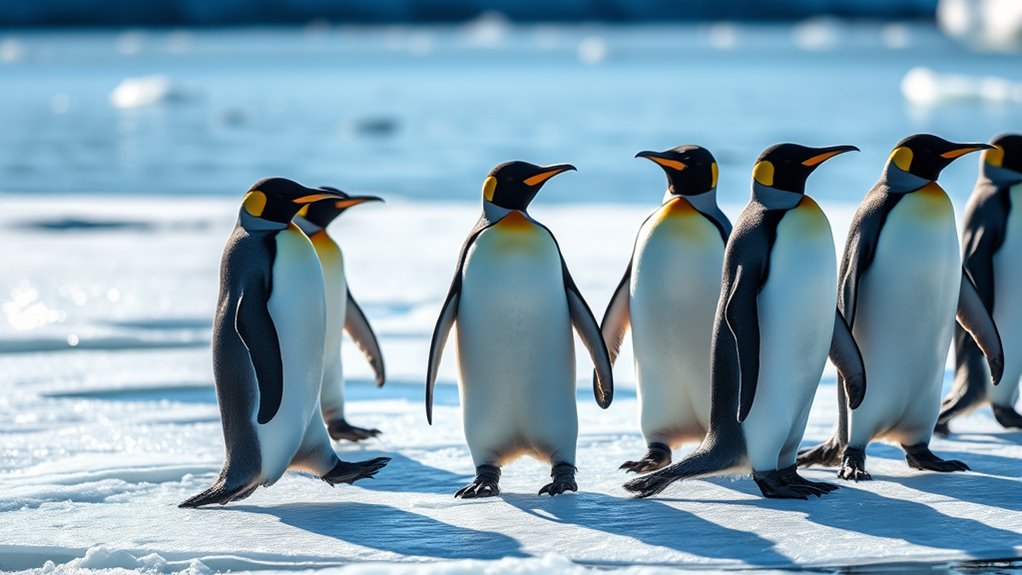
In their quest for energy efficiency, penguins have perfected a waddling gait that allows for smaller, quicker steps. This unique movement enables them to recover up to 80% of the energy expended per stride, enhancing their efficiency by 20% compared to human walking. The swaying motion acts like a pendulum, storing kinetic energy for future steps. This efficiency is essential during migration and hunting, helping them cover long distances without depleting their energy reserves.
| Aspect | Benefit |
|---|---|
| Energy Recovery | 80% per stride |
| Efficiency Increase | 20% compared to humans |
| Migration Advantage | Conserves energy |
| Hunting Capability | Enhances foraging |
Penguins vs. Other Birds

When you look at penguins compared to other birds, their flightlessness stands out as a key adaptation.
Instead of flying, they've developed unique movement techniques that help them conserve energy on land. This waddling gait isn't just charming; it's a smart solution for their environment.
Flightlessness and Adaptation
As penguins evolved from their flying ancestors, they adapted to a life spent primarily in the water, leading to remarkable anatomical changes that set them apart from other birds.
Their wing bones transformed into shorter, flatter flippers, enhancing their underwater agility. Unlike other birds, penguins developed thicker skeletons to support their buoyant bodies and larger breastbones to anchor strong swimming muscles.
Additionally, their compact ankles and knees, nestled within their body cavity, give rise to the distinctive waddling gait. This unique movement conserves energy, allowing them to recover up to 80% of the energy spent per step.
In this way, penguins have become more efficient movers on land compared to many other bird species, showcasing their remarkable adaptability.
Energy-efficient Movement Techniques
While many birds rely on flight for efficient movement, penguins have mastered a unique waddling technique that maximizes energy conservation on land.
Their waddling gait allows you to notice smaller, faster steps, enhancing energy efficiency compared to other birds of similar weight. The swaying motion acts like a pendulum, enabling penguins to recover up to 80% of the energy expended with each stride. This means they're about 20% more efficient than humans when walking.
Additionally, their shorter, compact ankles contribute to this less taxing movement style, proving advantageous during long migrations and hunting excursions.
In contrast to flying birds, penguins' evolution supports their aquatic lifestyle, focusing on energy conservation through their distinctive waddling.
The Significance of Waddling for Survival

Waddling plays an essential role in penguins' survival, allowing them to move efficiently across the icy terrain. This energy-efficient method helps them conserve important energy during long migrations and hunts.
By taking smaller, faster steps with a swaying motion, penguins can recover up to 80% of the energy expended per stride. Remarkably, they're about 20% more efficient than humans in locomotion, making this adaptation critical in harsh environments.
Their unique anatomy, with knees sitting within the body cavity, contributes to this waddling gait. Not only does waddling aid energy conservation, but it also enhances their agility and speed while swimming, which is imperative for both hunting and escaping predators in the frigid waters they call home.
International African Penguin Awareness Day

Celebrated on October 14, International African Penguin Awareness Day invites you to join the global movement aimed at protecting the endangered African penguin species.
This day encourages you to participate in waddles and events organized worldwide, from Cape Town to Tampa, showing your support for these remarkable birds.
By taking part, you not only raise awareness but also engage your community in essential discussions about penguin conservation.
Participating in this global event fosters vital conversations about penguin conservation within your community.
Social media plays a key role on this day, allowing you to share information and rally support for African penguins.
Your involvement highlights the importance of community action in wildlife preservation, encouraging everyone to contribute to marine conservation initiatives.
Together, we can make a difference for these beloved waddlers.
Conservation Efforts and Community Engagement

Participating in International African Penguin Awareness Day is just one way communities can come together to protect these remarkable birds. Events in places like Cape Town and Tampa unite people in waddles, generating funds and awareness for the endangered African penguin. The Two Oceans Aquarium plays a crucial role by engaging the public through conservation programs and educational initiatives.
| Activity | Purpose |
|---|---|
| Waddles on Awareness Day | Raise funds and awareness |
| Community events | Foster engagement and education |
| Newsletters | Keep the public informed |
| Online courses | Educate on wildlife preservation |
Your involvement helps guarantee the survival of African penguins and their habitats, emphasizing the need for ongoing public support.
Frequently Asked Questions
Why Do the Penguins Waddle?
You might notice that penguins waddle, and it's all about efficiency. This unique gait helps them conserve energy while moving around their icy habitats.
By taking smaller, faster steps, they can navigate better without tiring quickly. Their swaying motion acts like a pendulum, allowing them to recover much of the energy they use.
This clever adaptation is key to their survival, especially when hunting or migrating in harsh conditions.
What Are the Anatomical Adaptations of a Penguin?
Imagine a sleek, underwater torpedo gliding effortlessly through the ocean. That's a penguin for you!
Their anatomical adaptations are fascinating: shorter, flatter wing bones and thicker skeletons help them thrive in water. A robust breastbone supports powerful flipper muscles, while compact knees and ankles keep their waddling gait efficient.
With a streamlined body, they minimize drag and move swiftly, conserving energy for their underwater adventures. It's all about survival and elegance!
How Did the Penguin Get His Waddle?
You might wonder how the penguin got its waddle. Over time, penguins developed this unique gait to move efficiently on land.
Their knees are positioned within their bodies, which creates that distinctive waddling motion. This allows them to take smaller, quicker steps while conserving energy.
As they sway side to side, they maximize their energy recovery, making them more efficient movers compared to other animals of similar size. It's a clever adaptation!
Why Do Penguins Have Adaptations?
Penguins possess powerful physical adaptations for survival. These specialized structures support streamlined swimming and effective foraging.
Their stout skeletons and solid wings enhance agility in the water, while compact knees promote balance on land.
These unique traits help you understand how penguins thrive in harsh environments, maximizing energy efficiency during migration and hunting.
Conclusion
In the end, penguins' waddling isn't just a quirky trait; it's a remarkable adaptation honed by evolution. Each step they take, a tiny dance of survival, showcases their unique anatomy and energy efficiency. As you learn about these fascinating birds, remember that every waddle carries a story of resilience. By raising awareness and supporting conservation efforts, you can help guarantee that future generations continue to marvel at these charming creatures gliding across the ice.
